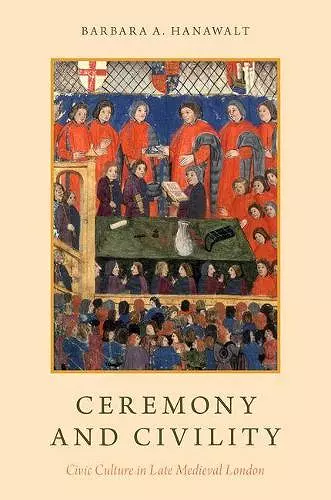Ceremony and Civility
Civic Culture in Late Medieval London
Format:Hardback
Publisher:Oxford University Press Inc
Published:21st Sep '17
Currently unavailable, and unfortunately no date known when it will be back
This hardback is available in another edition too:
- Paperback£29.99(9780190490409)

In Ceremony and Civility, Barbara Hanawalt shows how, in the late Middle Ages, London's elected officials and elites used ceremony and ritual to establish their legitimacy and power. These civic ceremonies helped delineate the relationship between London's mayors and the crown, but also between denizens and their government, between gild wardens and their members, between masters and apprentices, and between parishioners and their churches. London, like all premodern cities, had a largely immigrant population--only a small proportion of the inhabitants were citizens--and the newly arrived needed to be taught the civic culture of the city in order for that city to function peacefully. Ritual and ceremony played key roles in this acculturation process. In a society in which hierarchical authority was most commonly determined by inheritance of title and office, or sanctified by ordination, civic officials who had been elected to their posts relied on rituals to cement their authority, power, and dominance. Since the typical term of elected office was a year, elections and inaugurations had to be very public and visually distinct in order to quickly communicate with the masses: the robes of office needed to distinguish the officers so that everyone would know who they were. The result was a colorful civic pageantry. Newcomers themselves found their places within this structure in various ways. Apprentices entering the city to take up a trade were educated in civic culture by their masters. Gilds similarly used rituals, oath swearing, and distinctive livery to mark their members' belonging. But these public shows of belonging and orderly civic life also had a dark side. Those who rebelled against authority and broke the civic ordinances were made spectacles through ritual humiliations and public parades through the streets so that others could take heed of these offenders of the law. At the parish level, and even at the level of the street, civic behavior was taught through example, through proclamations, and even through performances, like ballads. An accessible look at late medieval London through the lens of civic ceremonies and dispute resolution, Ceremony and Civility synthesizes archival research in London with existing scholarship to show how newcomers in an ever-shifting population were enculturated into premodern London.
This book is valuable as an introduction to the culture of governance of a medieval town, and will no doubt be very helpful to undergraduates and others approaching the topic for the first time (for such readers, it contains a handy glossary of relevant terms). It also ffers a fresh perspective on the topic by virtue of its attention to the newcomers to the city and others who were not integrated into civic institutions. The paperback edition contains many reproductions (in greyscale) of prints, drawings and manuscript images which evoke the experience of the medieval city. * Charlotte Berry, The English Historical Review *
Hanawalt makes an original and valuable contribution by focusing on the integrative purpose of civic culture in a city where citizenship was the preserve of a relatively small group and real political power was even more restricted.This book is valuable as an introduction to the culture of governance of a medieval town, and will no doubt be very helpful to undergraduates and others approaching the topic for the first time.It also offers a fresh perspective on the topic by virtue of its attention to the newcomers to the city and others who were not integrated into civic institutions. * Charlotte Berry, English Historical Review *
In Ceremony and Civility, as in her earlier work, Hanawalt carefully sifts through the archival materials and listens to what the documents have to say about Londoners' ideas of order, their annual observances, and even the smells, sights, and sounds on the streets... The reader will soak in both the civic organization of medieval London and its rich ideological and performative accoutrements. As such, Ceremony and Civility has much to offer readers as they consider the complex use and meanings of space by and for medieval actors. * Kate Kelsey Staples, American Historical Review *
Hanawalt's long record of books that combine careful scholarship with an approachable style is extended here, with an appeal to general readers as well as to students....Highly recommended. * CHOICE *
Barbara Hanawalt's book is an excellent synthesis on London, exposing vividly nearly every aspect of urban life from the Guildhall to the ill-famed taverns. Her approach of the importance of the didactic nature of the ceremonies and rituals concerning the values and the power of the oligarchy is also very stimulating. Besides, it is well written and accessible to students and even a larger public, all the more so that it contains a glossary and an index of the notions, institutions and so on, explained in the book... This 'final book' of a fine historian is a great one and largely deserves to be read if one wants to understand the life of the most important city of late medieval England. * The Medieval Review *
ISBN: 9780190490393
Dimensions: 160mm x 239mm x 20mm
Weight: 488g
248 pages